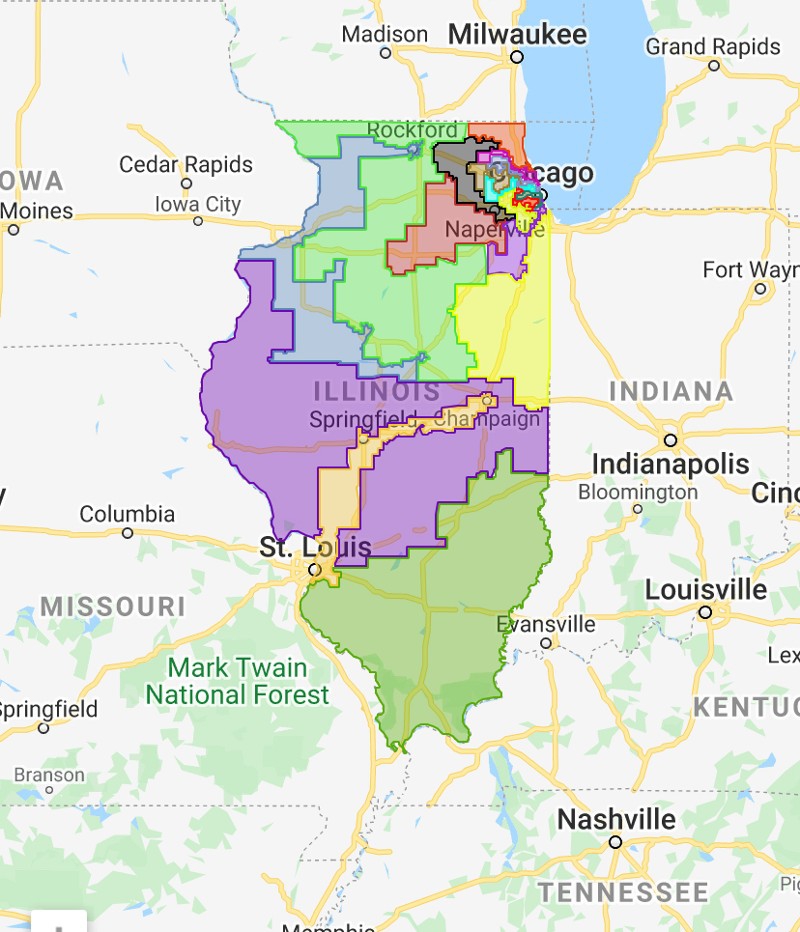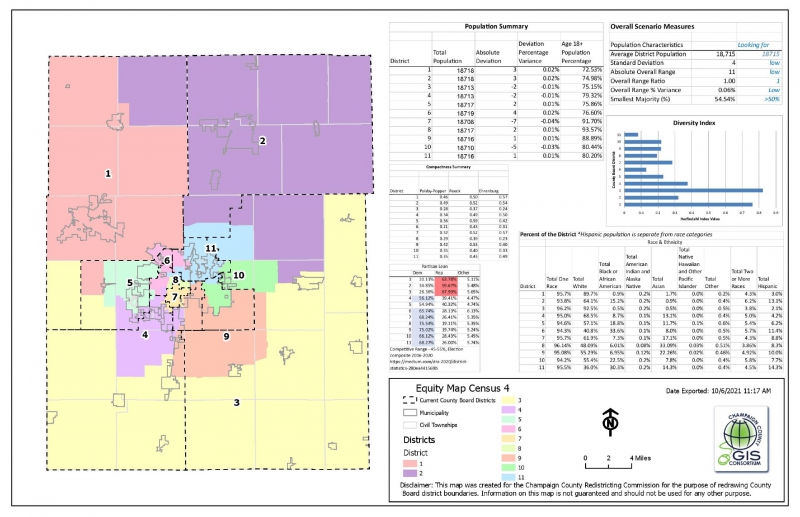Back in May, we speculated about the implications of redistricting at every level of government in Illinois. Now that the delayed 2020 Census numbers have been released, we took a look at the new maps created by Democratic majorities at the state and local levels. Democrats at the state level proposed new Congressional districts, accounting for the fact that Illinois will lose one seat. Democrats at the county level proposed their latest version of the “equity” map for county districts. Let’s take a look at each one.
Federal
Democratic lawmakers in Illinois have created two drafts of a map over the past few weeks, and both have been gerrymandered to give Democratic candidates an overwhelming advantage.

Screenshot from Google Maps.
On Wednesday, Democrats announced their latest draft of of congressional districts, which carves an IL-13 district through Champaign-Urbana, Decatur, Springfield, and Metro East that will flip the district to blue. The map pushes Rodney Davis into IL-15, where he could run in a very red district uncontested, at least by any current incumbents, and potentially not run for governor. Mary Miller, the current IL-15 rep, would be facing Mike Bost in his current district, IL-12. All in all, the current map would likely result in 14 Democratic districts and 3 Republican districts.
County
In May, Democrats on the county board proposed and voted along party lines on their “equity map,” which was subsequently vetoed by County Executive Darlene Kloeppel. The veto was overridden. Once Census data became available, and to address Kloeppel’s complaints of too much population variance between districts, the Democrats brought a new map to the table, which passed along party lines last week.

Image from Champaign County Board website.
The new map creates three majority-minority districts. Districts 6 and 11 would be majority Black and Hispanic, and District 8 would be majority Asian. The map also shifts District 4 from a “toss up” district to one that leans Democratic, leaving three lean-Republican districts, seven Democratic, and one considered a toss up, but still with a higher percentage of Democratic voters.
So, what does this potentially mean?
It should surprise no one that both of these maps are configured to heavily favor Democrats.
If we look at the balance of power at the federal level right now, we can see how precarious slim majorities are. There is a razor thin Senate majority that is barely a majority because of two Democratic Senators who don’t seem to be interested in accomplishing anything as the party in power. And from D.C. to Champaign County, it is abundantly clear that the Republican party is more interested in “owning the libs” than doing anything to improve the lives of their constituents.
The discourse coming from Illinois Republicans at every level is exhausting and performative. Rodney Davis had plenty of complaining to do about Governor Pritzker and map fairness before the new congressional map was unveiled, but has been markedly quiet now that he has a staunchly Republican district all to himself, where he wouldn’t have to worry about a Democratic challenger, or listen to pesky constituents from the other side. Is gerrymandering congressional districts a great thing? No, it’s not. But a conservative majority on the U.S. Supreme Court decided in 2019 that political gerrymandering is not unconstitutional, opening the doors to allow this sort of political maneuvering. As long as it’s going to happen in Republican-controlled states, and without the passage of H.R. 1, which would have ended partisan gerrymandering, what choice do Democrats have but to fight fire with fire?
At the county level, Republican board member Jim Goss has been especially vocal about his opposition to the new district lines with complaints such as: “It’s obvious that the Democrat [sic] party of Champaign County cares only about the power” and “it’s not about equity, it’s about power and control. It is so these same Democrats can complete their mission to trash this once proud county.”
It’s difficult to blame county Democrats for wanting more control over the board, when some of their Republican colleagues would rather mutter profanities, make unsubstantiated accusations, and refuse to direct funding to the people who need it the most. Why wouldn’t Democrats take a shot at being able to get things done without needing to persuade the unpersuadable?
The ever-widening partisan divide is frustrating at every level of government, but as long as one party has decided to be the party of insurrection, voter suppression, and obstruction, the other party must use every tool in the toolbox to fight back.
The Editorial Board is Jessica Hammie, Julie McClure, Patrick Singer, and Mara Thacker.








